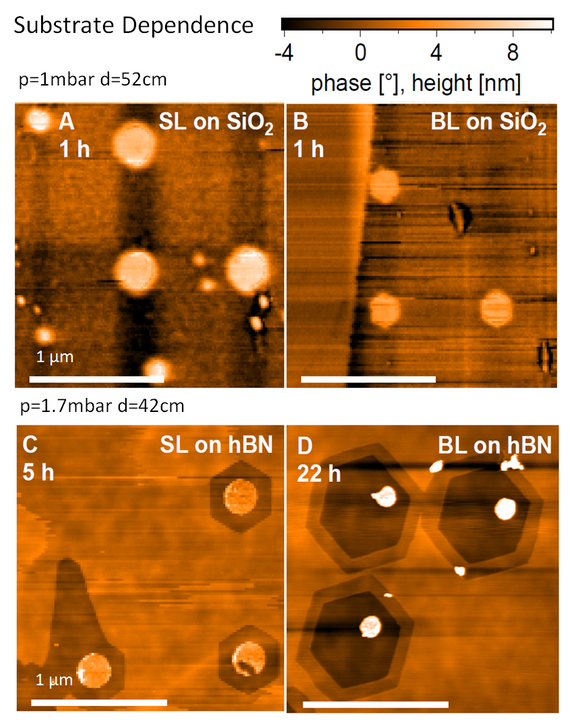Graphene Nanoribbons

Anisotropic H-Plasma Etching of Graphite and Graphene on hBN
D. Hug, S. Zihlmann, M. K. Rehmann, Y. B. Kalyoncu, T. N. Camenzind, L. Marot, K. Watanabe, T. Taniguchi, and D. M. Zumbühl
"Anisotropic Etching of Graphite and Graphene in a Remote Hydrogen Plasma"
npj 2D materials and applications 1, 21 (2017), manuscript pdf, supporting materials pdf
Motivation
Confining graphene in form of a nanoribbon opens up an electronic gap in its band structure which is absent in bulk graphene. Graphene nanoribbons (GNRs) have emerged as a promising platform for intriguing quantum phenomena and applications in spintronics and quantum computation. GNRs can be fabricated with two kinds of crystallographic edges: zigzag and armchair. Zigzag ribbons are proposed as a host for spin filters [1]. Theory predicts that electronic states in zigzag ribbons are strongly confined to the edge and edge magnetism was predicted to emerge at low temperatures [2]. High quality, crystallographic edges are very important here, since edge disorder suppresses magnetic correlations and tends to cause electron localization. GNRs fabricated with standard e-beam lithography and Ar/O2 etching typically exhibit pronounced disorder [3], inhibiting transport studies. Fabrication of high quality ballistic ribbons with well-defined crystallographic edges is very challenging.
Results
We investigate the etching of a pure hydrogen plasma on graphite samples and graphene flakes on SiO2 and hBN substrates. It has been shown that exposure of graphite to H-plasma creates hexagonal etch pits starting from defect sites, with edges oriented in the zigzag direction [4]. The observed pressure and distance dependence reveals the existence of two plasma regimes. The direct plasma regime exhibits many hexagonal etch pits of various sizes indicating continuous induction of defects, due to energetic ions in the active plasma. In the remote plasma, the anisotropic etching occurs only at the pre-existing defect sites without inducing new defects. In this remote plasma regime, we examine the etching of single layer and bilayer graphene on SiO2 and hBN substrates. We find isotropic etching for single layer graphene on SiO2whereas we observe highly anisotropic etching for graphene on an hBN substrate. We characterize the process for different sample-plasma distances and pressures such that etching parameters are fully controlled.
Conclusion and Outlook
With this method it is possible to pattern graphene nanostructures of various geometries and dimensions with clean crystallographic edges. Inducing artificial defects by lithography controls the position and the etching duration controls the size of the hexagonal etch pits. This leads to the opportunity to fabricate GNRs with well-defined edges on a well suited substrate, further allowing hBN encapsulation for high mobility devices to perform electronic transport experiments.
[1] Y. W. Son et al., PRL,97 (2006) 216803
[2] Y. W. Son et al., Nature,444 (2006) 347
[3] E. Mucciolo et al., PRB,79 (2009) 075407
[4] R. Yang et al., Adv. Mat.,22 (2010) 4014
